Upon seeing chimpanzees for the first time, most people are struck by the extensive physical similarities between our two species, but there’s one notable difference that also catches everyone’s attention…
What’s wrong with their butts?
Chimpanzees, along with many other primates such as baboons and macaques, advertise their fertility by means of sexual swellings. As they approach ovulation, ovarian hormones induce the skin around their genitals to swell and take on a pink hue, an effect known as tumescence. Following ovulation, other hormones cause the swelling to subside and the roughly 35-day menstrual cycle begins again.
Why does this happen? Believe it or not, no one really knows for sure. It could be that it promotes paternal care by increasing the certainly that a particular male was the father of a female’s offspring. Or it could increase competition between males for mating access, thereby helping females filter for males with greater fitness. Or it could provide more immediate benefits to the females, as the males must work to protect them during their consortships. The list of hypotheses goes on, but none seem to be fully supported by the data on their own. In all likelihood, it is some combination of these factors. Interestingly (to primatologists, anyway), a recent study of free-living bonobos found that while they exhibit sexual swellings, their swellings do not reliably indicate fertility as they do in their chimpanzee cousins. Like humans, it seems that bonobos conceal ovulation. Bonobo societies are structured very differently than chimpanzee societies – they are quite famously female dominated – so it may be that a different evolutionary strategy was required.
One thing is for sure – swellings have a significant effect on male chimpanzees. Male chimpanzees aren’t exactly the more level-headed of the two sexes to begin with, but when tumescent females are present, all bets are off. Those big, pink backsides make the females incredibly attractive to the males and it can ignite a lot of testosterone-fueled behavior. In addition to an overall uptick in group tension and aggression, one result we often see is a behavior called mate guarding.
I remember learning about mate guarding the hard way when volunteering at another sanctuary. I was just getting to know two young adult chimps named Jethro and Rachel and I enjoyed interacting with both of them each time I visited. Then one day, all I did was say hello to Rachel and before I knew it, Jethro had spit a huge mouthful of water directly in my face. The lesson was clear: Rachel was off limits when she had her swelling.
We don’t see mate guarding per se here at CSNW, but that’s not to say that Burrito is unaffected by the swellings of the females in his group. He loves them. He loves them so much that he follows the girls wherever they go when they have their swellings. He loves them so much that he sleeps on the floor below the benches where the girls makes their nests so that he can stare at them all night.
Sadly, Burrito never exhibits any other mating behavior. Many chimps raised in unnatural environments like laboratory nurseries or human homes never develop these skills, despite some rather obvious biological urges. But while his interest in the girls may be limited to looking, he is unrelenting. In the wild, the young, tumescent females – dubbed “pink ladies” by Jane Goodall – are said to like the attention it brings them. My guess is that Burrito’s group mates would gladly send him off on a vacation one week each month if they could.
Among the Cle Elum Seven, only Annie, Jamie, and Jody experience sexual swellings. Foxie and Missy had complete hysterectomies shortly before coming to the sanctuary due to the discovery of uterine tumors during their pre-shipment physicals. As a result, they no longer experience the same estrogen and progesterone cycles that govern these swellings. And while we have no record of Negra undergoing a hysterectomy, she doesn’t cycle either. Menopause isn’t common in chimpanzees, but just as we see in humans, there are other factors that can disrupt or cease menstrual cycles.
There is a lot of natural variation in the size of the females’ swellings, and on top of that, physical trauma to the sex skin can cause it to lose its shape. So some swellings, like Annie’s, are barely noticeable, while others, like Jody’s, are so big they make sitting down difficult. According to Burrito (and much of the scientific literature) it seems that bigger is generally better, but that probably depends on your perspective.
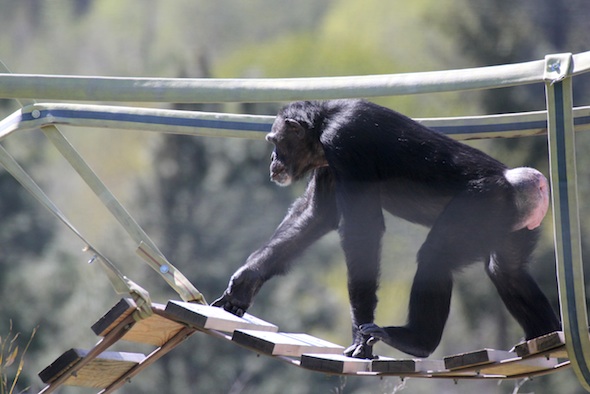
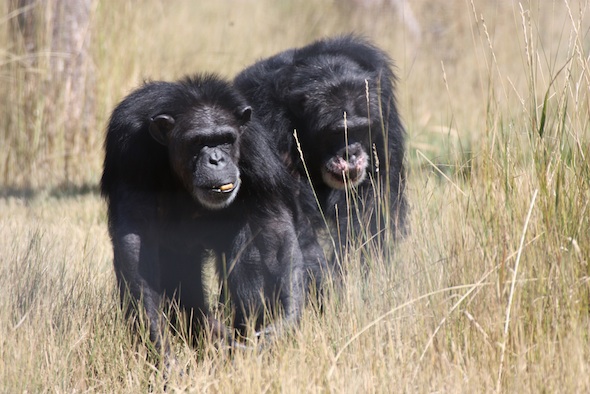
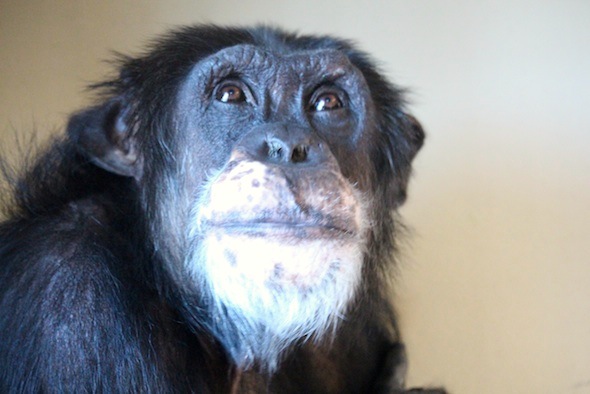
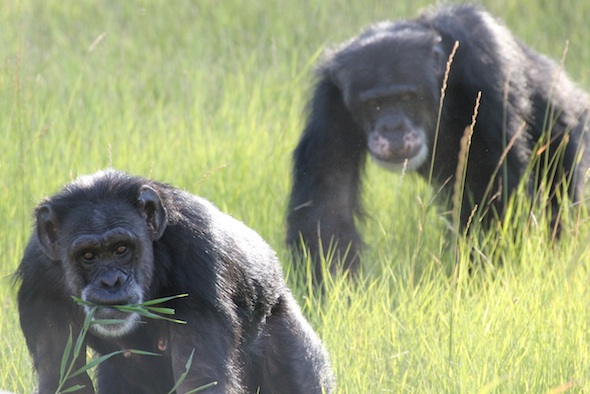

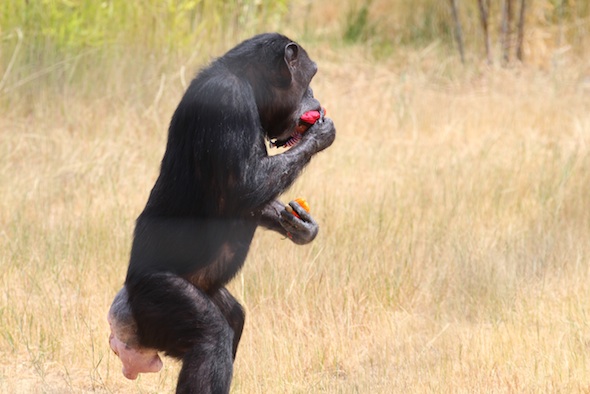





Bonobos exhibit this “swelling” signalling estrus as well, but over a much longer time…
Excellent article! Educational and humorous 🙂
I knew there was a sexual cycle to swelling, but have always been curious by those that seem to be that way all the time. Since Jamie is more frequently photographed, she’s the one I noticed seemed to have that swelling permanently. So you’re saying it’s some sort of trauma/ damage?
That’s a good question! Jamie actually has very little trauma to her sex skin, but her “flat” state (detumescent) is naturally larger than Annie’s, for example. So there’s variation in size between individuals even when they are not in estrus. Jody’s swelling (last photo in the post) has been subject to a lot of trauma which is why it sticks out all over the place and is never truly “flat”.
Thanks for this! I’ve wondered about the butts issue (kind of hard to miss), but haven’t taken time to ask the question. Now I don’t have to.
Thank you J.B. for this explanation. I am pleased to know sweet Burrito has some natural stirrings and that everything wild and instinctual wasn’t taken from him. Boys will be boys no matter what. ; ) Love that close up photo of him!
I’ve always wondered and I’m glad to know that I was close to the answer……..
Thanks so much for the information.
Hi,
I love your fb page and all the great info you have on your chimps. I was however a bit surprised at your explanation of chimps “menstrual cycle”. Chimps do not have a menstrual cycle, they have an oestrus cycle which is not the same. To menstruate is to shed the lining of the uterus, something unique to humans ( and maybe whales or dolphins I heard once)?
Hmm, no, I appear to be wrong! My apologies, it seems primates do in fact menstruate.
You have answered so many questions I had about the girls and burrito too! Thanks….
Fascinating information. Clearly lots of us really appreciate the Chimp bio lesson. Thanks for continually keeping us well informed!
Thanks. Answered a somewhat delicate question but begs another question: do the hormonal cycles run in sync due to the females’ proximity? It’s happened to me more than once when living with female roommates.
Good question. No, not that we have seen. There’s only one study of menstrual synchrony in chimpanzees that I am familiar with and it found no effect: http://www.ncbi.nlm.nih.gov/pubmed/15940707
In fact, the scientific literature now suggests that it may not exist in humans either: http://blogs.scientificamerican.com/context-and-variation/menstrual-synchrony/
Thanks for the links J.B. I will check them out.
As long as we are discussing things that make people laugh nervously and tug at their collars…..I think about the gigantic daily laundry project and wonder whether the chimps soil their blankets instead of choosing somewhere else to use the bathroom. It’s difficult to understand why such an intelligent animal would not want to distance itself from its body waste………..Ginny F.
Hi Ginny – They don’t intentionally soil their blankets, but that doesn’t mean that they’re very careful where they go either. Chimps typically swing their butts over just about any ledge to go to the bathroom, regardless of what’s beneath them. This is how many of the blankets get soiled. Also, when they are displaying or fighting, many objects, including blankets, get tossed around and dragged through any waste that might be on the floor. We clean every area once a day, and some twice a day, but there is bound to be something on the floor at any given time. They also take food to their nests on occasion and leave bits and pieces behind.
And as chimps get older, have multiple pregnancies, etc., they can develop incontinence. We’ve noticed that Negra’s nests are more likely than others to be soiled with urine.